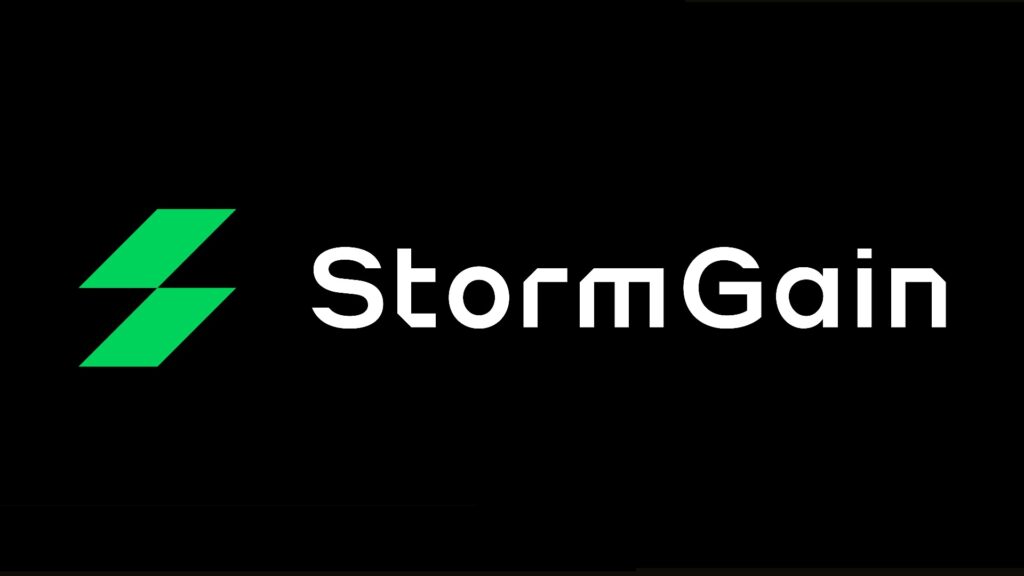StormGain and Binance are notable cryptocurrency exchanges with distinct advantages. StormGain offers a user-friendly interface, high leverage, spot and futures trading, a built-in wallet, and cloud mining, ideal for new and intermediate traders. Binance, a global leader, provides extensive cryptocurrencies, high trading volumes, advanced tools, and comprehensive services, including staking and savings.
When choosing a cryptocurrency exchange, you’ll want to compare key features to make an informed decision. Below, find a summary table that contrasts StormGain and Binance across various criteria, including fees, supported coins, and more.
| Feature | StormGain | Binance |
|---|---|---|
| Trading Fees | 0% commission for OTC, 10% profit share on profitable trades | Variable, based on trading volume and BNB balance |
| Deposit Methods | Debit/Credit Cards | Multiple including bank transfer, credit cards, and cryptocurrencies |
| Supported Coins | Offers popular coins like Bitcoin, Tether, Dash, Monero, Tron | Wide range of cryptocurrencies and tokens |
| User Experience | Proprietary trading terminal available on web and mobile | Advanced features for traders, user-friendly interface |
| Leverage | Available on certain trades | Higher leverage options available |
| Security Allegations | Not indicated in the snippets | Facing lawsuits from SEC for alleged securities violations |
StormGain focuses on simplicity with a flat-fee pricing model and a user-friendly platform suitable for traders of various skill levels. In contrast, Binance offers a more complex fee structure that may benefit high-volume traders. Additionally, Binance provides a larger selection of cryptocurrencies and advanced trading features.
Your choice might depend on the depth of trading you’re aiming for and the level of risk you’re willing to accept, especially considering the current legal challenges Binance is facing.
Remember, it’s important to conduct your own research beyond this glance to ensure that the exchange you choose aligns with your trading goals and risk tolerance.
StormGain vs Binance: Products and Services
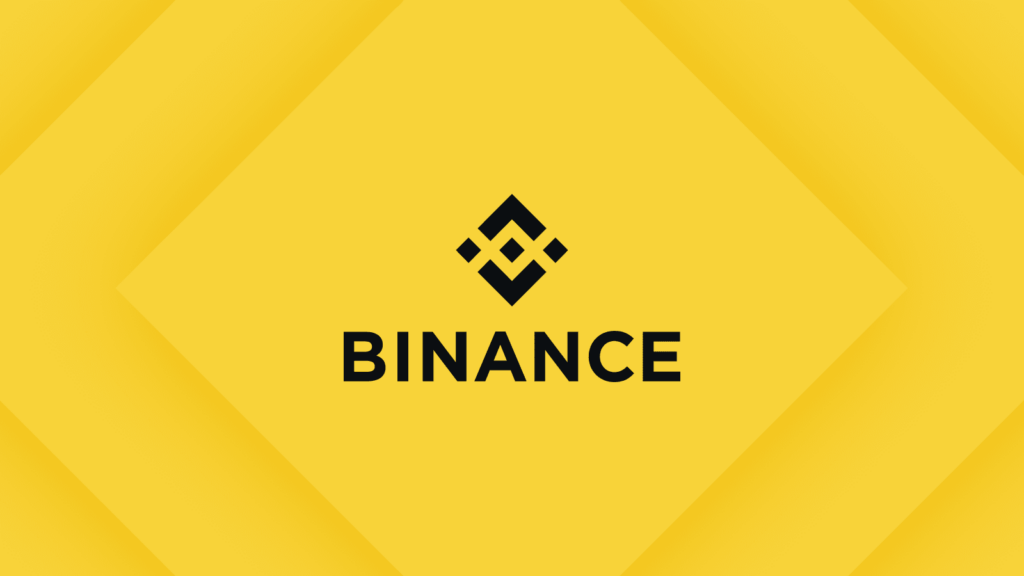
When you examine StormGain and Binance, you’ll notice a range of offerings tailored to different cryptocurrency enthusiasts’ needs.
Binance, established and recognized for its extensive product lineup, offers a comprehensive ecosystem. You have access to spot trading, an advanced platform for futures trading, and options trading, catering to various risk appetites. Not just limited to trading, Binance also provides an NFT marketplace for the growing digital art sector and opportunities for staking. Its innovative edge is evident in the variety of leveraged tokens available.
In contrast, StormGain operates with a narrower focus. While it supports spot trading, one of its key attractions is the integration of crypto cloud mining, which is not a service found on Binance. This can offer you a passive way to accumulate digital assets. Additionally, StormGain offers deposit bonuses and is known for its ease of use, particularly for newer entrants to the crypto space.
Below is a brief overview of the services each platform offers:
| Service | StormGain | Binance |
|---|---|---|
| Spot Trading | Yes | Yes |
| Futures Trading | Limited | Extensive |
| Options Trading | No | Yes |
| Leveraged Tokens | No | Yes |
| NFT Marketplace | No | Yes |
| Staking | No | Yes |
| Crypto Cloud Mining | Yes | No |
| Educational Resources | Yes | Yes |
Although Binance leads in diversity, the user experience on both platforms is tailored to their respective audiences. Your choice may ultimately hinge on whether you’re seeking a broad marketplace with advanced trading tools (Binance) or a streamlined platform with unique features like mining (StormGain).
StormGain vs Binance: Contract Types
When exploring contract types on StormGain and Binance, you’ll find a variety of options tailored to different trading strategies.
StormGain doesn’t offer as broad a range of contracts as Binance; however, their platform does provide users with access to tokenized assets, which are a form of smart contracts. These contracts are based on the price movements of physical assets like gold and silver.
On the other hand, Binance boasts a more extensive selection of contract types:
- Inverse Perpetual Contracts (COIN-M Futures): These contracts use cryptocurrency as the margin and settlement currency. They are useful as you can trade against the long-term value of a coin.
- Linear Perpetual Contracts (USDT-M Futures): These are quoted and settled in stablecoins, like USDT. They offer the advantage of straightforward calculations for profit, loss, and margin balance.
- Inverse Futures Contracts: Much like inverse perpetual contracts, these are settled in the underlying cryptocurrency and tend to suit those comfortable dealing with the inherent cryptocurrency volatility.
- Options: These are financial instruments granting you the right, but not the obligation, to buy or sell an asset at a predetermined price. Binance’s European-style options settle in USDT, simplifying the process for traders by avoiding the need for multiple currencies.
Each contract type has its own merits and risks. It’s essential that you consider these alongside your trading strategy and risk tolerance.
Remember, while Binance offers a broader range of contracts, StormGain’s focus on simplicity with tokenized assets might be a better fit if your goal is to engage with the digital representations of traditional investment assets.
StormGain vs Binance: Leverage and Margin
Leverage trading is a powerful tool that you can use to amplify your trading position beyond your initial investment. Both StormGain and Binance offer leverage, but their terms and options vary significantly.
StormGain provides you with the possibility to trade cryptocurrencies with leverage up to 200x. This high level of leverage means a smaller amount of capital can lead to greater exposure in the market. However, remember higher leverage also increases liquidation risk, meaning your positions could be automatically closed if the market moves against you significantly.
On the other hand, Binance offers leverage up to 100x on its futures platform. Leverage at Binance allows you to enter larger positions while committing a fraction of the capital. Yet, the same principle applies: increased leverage entails higher risk of liquidation.
For margin requirements, both exchanges have policies to protect against negative balance and to ensure you do not lose more money than you have in your margin account. If your margin level gets too low, both platforms issue margin calls and could force the liquidation of your assets to cover the loss.
| Feature | StormGain | Binance |
|---|---|---|
| Maximum Leverage | 200x | 100x |
| Margin Call | Yes | Yes |
| Liquidation Protection | Yes | Yes |
| Funding Rates | Varied | Varied |
Both platforms have variable funding rates, which are payments made for holding a leveraged position and can vary depending on market conditions.
Before engaging in leverage trading on StormGain or Binance, ensure you understand the terms and risks. Leverage can magnify profits as well as losses, which is crucial to consider when managing your trading strategy.
StormGain vs Binance: Liquidity and Volume
When you’re choosing a cryptocurrency platform, liquidity and volume are critical factors that can significantly influence your trading experience. These aspects determine how rapidly and efficiently you can execute trades, as well as the likelihood of facing slippage, which can affect the price at which your trade is executed.
Binance, with its considerable average daily trading volume which often exceeds billions, stands as one of the largest cryptocurrency exchanges globally. This high volume ensures substantial liquidity, allowing for swift execution of trades, typically without significant price slippage.
On the other hand, StormGain reports an average daily trading volume of over $750 million. While this is a respectable figure, especially for an emerging exchange, it’s lower compared to Binance’s volume. Even though this may suggest less liquidity than Binance, for most individual retail traders, StormGain’s liquidity is likely sufficient to support efficient trade execution for the majority of trading pairs.
It’s important to consider the following:
- High-volume exchanges like Binance tend to provide more liquidity, which could mean tighter spreads and less price slippage.
- The rankings and metrics from reliable financial sources can serve as a gauge for liquidity and volume. Binance typically ranks within the top tier for global trade volume.
- Your funds’ security should also be a priority when comparing exchanges. Binance has faced regulatory scrutiny, and it’s crucial to stay informed about any developments that may impact liquidity.
Each exchange’s liquidity may affect different cryptocurrencies differently. If you’re planning to trade less common coins or engage in large volume transactions, Binance’s higher liquidity might be more suitable to your needs. For standard operations, StormGain’s liquidity is often ample, although it could present limitations for more substantial trades or less popular trading pairs.
StormGain vs Binance: Fees and Rewards
When comparing StormGain and Binance, understanding their fee structures and reward systems is crucial for your trading strategy.
StormGain:
StormGain employs a straightforward fee model. They charge no commission for Over-The-Counter (OTC) trades, while a 10% profit share is taken from only profitable trades. Depositing via debit or credit cards attracts certain commissions.
Example: If you make a $1000 profit on a trade, StormGain would take $100 as their profit share.
Binance:
Binance operates on a tiered fee structure based on your 30-day trading volume and Binance Coin (BNB) balance, with fees starting at 0.1%. Holding BNB may also grant you trading fee discounts.
Example: A $10,000 trade at the 0.1% fee rate would cost you $10 in fees.
Rewards:
- StormGain: Offers a loyalty program that can include bonuses on deposits, as well as lower commission rates depending on your status.
- Binance: Provides various rewards, such as a referral program giving you a percentage of trading fees from referred accounts and the potential to earn interest on your cryptocurrency holdings through staking.
Remember that fees can impact your profitability, so take advantage of any discounts, like Binance’s BNB discounts, to lower your trading costs. Always review the fee and reward structures for the most up-to-date information, as they can change.
StormGain vs Binance: Trading Fee & Deposit/Withdrawal Fee Compared
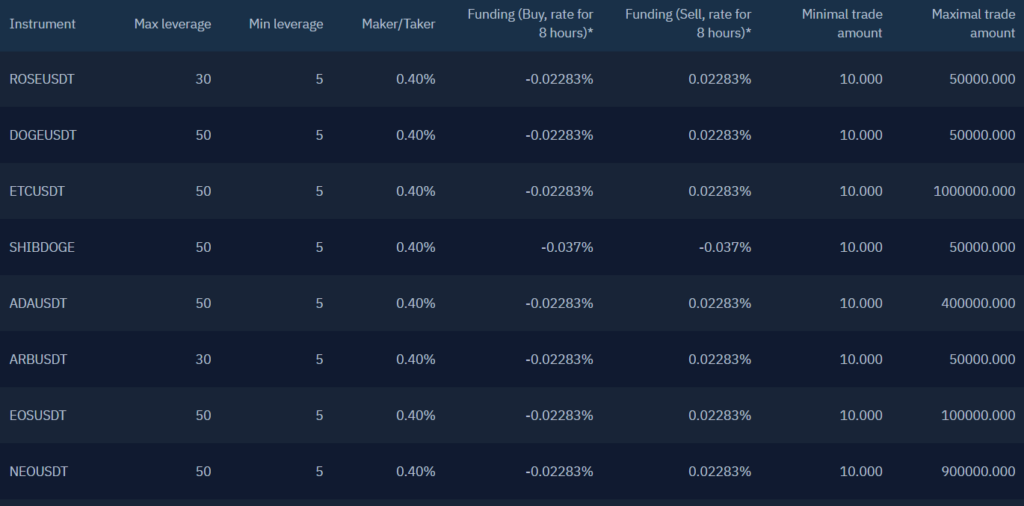
When you’re trading on StormGain, you will encounter a flat-fee model. You don’t pay commission for over-the-counter (OTC) trading, but there’s a catch: if your trades are profitable, StormGain charges a 10% profit share. This could impact your net earnings, depending on your trading success.
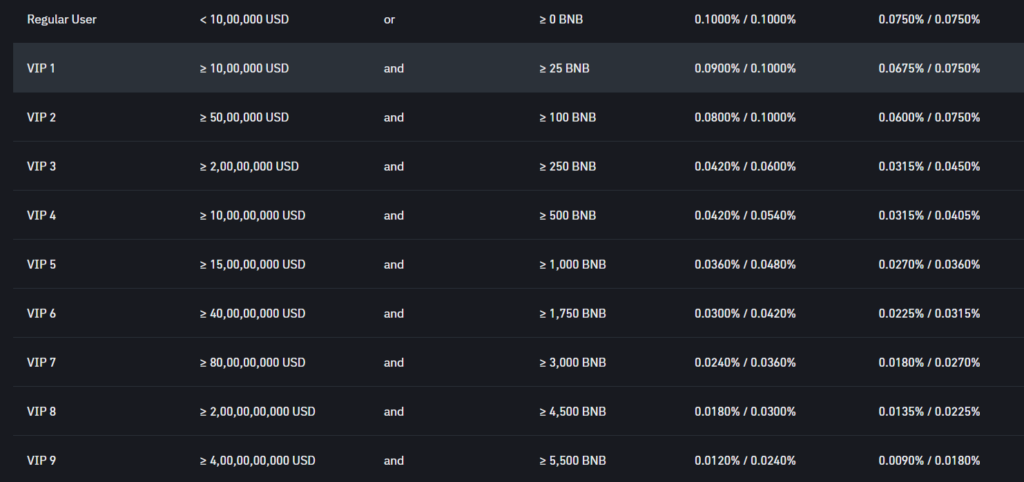
In contrast, Binance utilizes a maker-taker fee schedule. For spot market transactions, this typically ranges from 0.02% to 0.1% for makers and 0.04% to 0.1% for takers, depending on your 30-day trading volume and Binance Coin (BNB) balance. This structure can be favorable for high-volume traders seeking lower fees.
Regarding deposits, StormGain imposes a commission on debit/credit card transactions, whereas Binance generally offers free crypto deposits but may charge for fiat transactions depending on the method used. The specific rates are payment method-dependent, so it’s key to check the most current fees before you proceed.
Withdrawal fees are also an important factor for any trader. Binance has a variable withdrawal fee depending on the cryptocurrency, which can be as low as $1.5 USD for bank transfers. Conversely, StormGain doesn’t support bank transfer withdrawals, and the debit/credit card withdrawal fees start from $10. These costs must be considered, as they can accumulate, especially with frequent withdrawals.
| Exchange | Maker Fee | Taker Fee | Deposit Fee | Withdrawal Fee |
|---|---|---|---|---|
| StormGain | 0% (OTC) | 10% (profit) | Debit/Credit: Varies | Debit/Credit: from $10 |
| Binance | 0.02% – 0.1% | 0.04% – 0.1% | Crypto: Generally free, Fiat: Varies | Crypto: Variable, Bank Transfer: 1.5 USD |
Remember, these fees are subject to change and can vary by account level and other discounts provided by the respective platforms. Always check for the latest fee structure directly on the exchange’s website before trading.
StormGain vs Binance: Deposits & Withdrawal Options
When choosing a cryptocurrency exchange, understanding the specifics of deposit and withdrawal options is crucial for managing your funds efficiently.
Both StormGain and Binance offer different methods for depositing and withdrawing money, each with its own set of currencies, processing times, and limits.
StormGain supports a variety of deposit methods:
- Credit/Debit Cards: Commonly used for convenience, although fees may apply.
- Cryptocurrency Deposits: Supports various cryptocurrencies, typically processed within minutes.
Withdrawals are generally straightforward with cryptocurrency options available. You might find variable minimum and maximum limits, so checking the latest terms is advisable.
Binance, known for its broad array of services, provides diverse options:
- Bank Transfer: SEPA, SWIFT, and other local options with varying processing times.
- Credit/Debit Cards: Available for direct purchases and wallet funding.
- Cryptocurrencies: Supports a wide range, often featuring quicker processing times.
Minimum and maximum amounts for Binance transactions can differ based on your verification level and chosen currency. It’s worth noting that Binance has faced scrutiny over its practices, which may affect your consideration of its services.
For both StormGain and Binance, the speed of fund transfers can also depend on the currency and network congestion. Always keep in mind that fees are subject to change, so regular review of the exchanges’ fee structure is recommended to avoid any surprises.
Remember, your choice should align with your needs for cost-effectiveness, speed, and a seamless experience in managing your cryptocurrency transactions.
StormGain vs Binance: KYC Requirements & KYC Limits
When you decide to engage with cryptocurrency exchanges like StormGain and Binance, understanding their Know Your Customer (KYC) requirements and related limits is crucial for a smooth trading experience.
StormGain KYC Requirements:
- Mandatory Verification: To start trading, you must complete the verification process.
- Documentation: Typically involves official identification like a passport or driver’s license.
- Account Types: Divided into Real and Demo accounts, with Demo accounts not requiring KYC.
Binance KYC Requirements:
- Optional Verification: For basic accounts, Binance allows limited trading without KYC. For more advanced trading features and higher limits, KYC is required.
- Documentation: You’ll need to submit government-issued ID and potentially further documentation for higher tiers.
- Verification Levels: Ranging from unverified to fully verified, with each level granting increased access and limits.
| Feature | StormGain | Binance |
|---|---|---|
| Verification Need | Mandatory | Optional (Tier-based) |
| Basic Account | KYC Required | No KYC for low limits |
| Advanced Account | KYC Required | KYC Required |
| Documentation | Government ID | Government ID + Others |
| Demo Account | No KYC | Not Applicable |
KYC limits directly impact how much you can deposit, withdraw, and trade:
- StormGain: All account types that involve real money require complete KYC verification; thus, limits on financial operations are tied to compliance.
- Binance: Offers more flexibility with its tier system. Without verification, you can deposit cryptocurrencies but face restrictions on withdrawals. Enhanced verification raises your withdrawal and trading limits considerably.
Your choice of platform will depend on how you prioritize privacy against the desire to trade larger volumes or access more advanced features. If you’re looking for the freedom to trade without KYC, Binance may offer an advantage. For full access to all features and the assurance that all users are verified, StormGain is your go-to.
StormGain vs Binance: Order Types
When trading cryptocurrencies, the types of orders you can place are essential tools for implementing your trading strategies and managing risks effectively. Here’s a comparison of the order types offered by StormGain and Binance:
Market Orders
- StormGain: Enables you to buy or sell a cryptocurrency at the best available current price.
- Binance: Similarly, lets you execute trades immediately at the current market price.
Limit Orders
- StormGain: Allows setting a specific price to buy or sell a cryptocurrency.
- Binance: Offers this feature, enabling you to specify the price at which you wish to execute a trade.
Stop Orders
- StormGain: Utilizes stop orders to buy or sell once the asset reaches a particular price.
- Binance: Provides stop-loss orders, helping you to limit losses or protect profits.
Conditional Orders
- StormGain: May not have explicit conditional orders.
- Binance: Supports OCO (One Cancels the Other) orders, combining a limit with a stop-limit order.
Advanced Order Types
- Binance also offers advanced order types such as:
- Post-Only Orders: Ensure the order adds liquidity to the market and doesn’t fill immediately.
- Reduce-Only Orders: Used in margin trading to reduce a position but not increase it.
Both platforms provide tools necessary for effective risk management and strategic execution of trades. However, Binance has a wider range of advanced order types, which might be more beneficial for experienced traders looking for flexibility and precision when managing their cryptocurrency trading strategies.
StormGain vs Binance: Security and Reliability
When evaluating the security measures of StormGain and Binance, it is crucial to understand how each platform safeguards your funds and personal data.
StormGain boasts a robust security suite. It employs SSL encryption to help protect your transactions, reinforces compliance with PCI-DSS and GDPR standards, and involves real-time monitoring systems. Their commitment to security is further exemplified by quarterly security audits and the implementation of two-factor authentication (2FA) for additional account protection.
Binance, as one of the largest cryptocurrency exchanges, has also implemented strong security protocols, including 2FA and advanced encryption technology. However, they have faced scrutiny, as they are reportedly being sued by the SEC for alleged securities violations that may have included commingling of client funds and ‘wash trading’. Despite this, Binance has a substantial user base and has taken steps to resolve past issues, reinforcing their stance on protecting users.
Both exchanges are actively working to remain compliant with industry regulations, adjusting their operations to meet legal standards set by different countries. This regulatory adherence can enhance their reliability.
| Feature | StormGain | Binance |
|---|---|---|
| SSL Encryption | Yes | Yes |
| Compliance | PCI-DSS, GDPR | Varies by region |
| Real-Time Monitoring | Yes | Yes |
| Security Audits | Quarterly | Periodically |
| Two-Factor Authentication | Yes | Yes |
| Regulatory Actions | No major incidents reported | Securities violations lawsuit |
| Customer Support | Available | Available |
While StormGain has not been the subject of major regulatory scrutiny, Binance’s legal challenges highlight the importance of considering an exchange’s history when evaluating its reliability. Both platforms strive to offer secure and dependable environments for cryptocurrency trading, suggesting your interests remain a priority.
StormGain vs Binance: User Experience
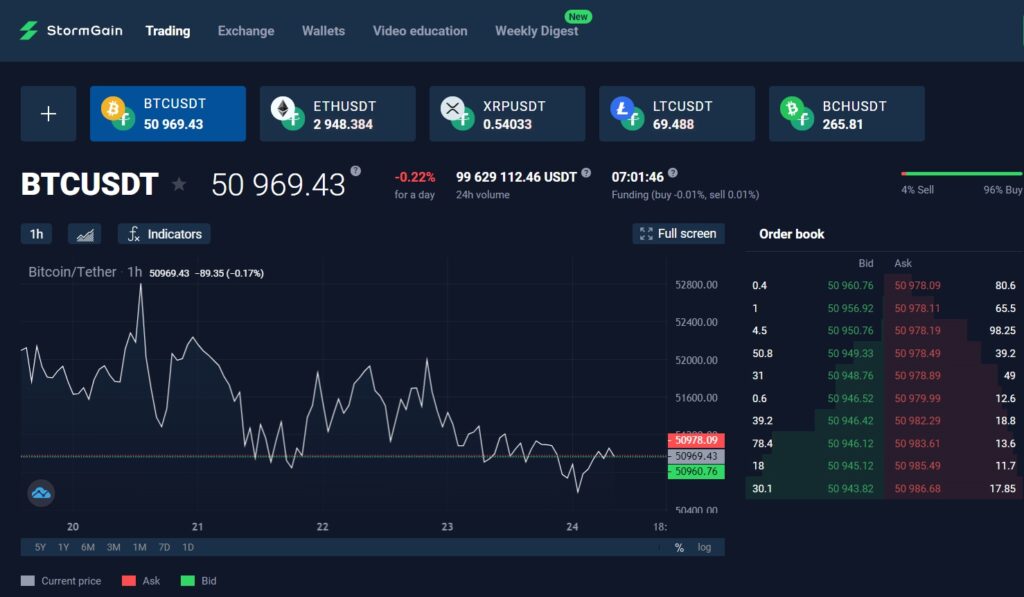
StormGain’s platform is intuitive, designed primarily for novice traders. It offers simple navigation and clear presentation of options. This straightforward approach to cryptocurrency trading can be beneficial if you’re starting out or prefer a less complicated trading experience.

On the other hand, Binance offers a comprehensive experience that accommodates both beginner and expert traders. With a detailed interface and a wide array of tools, it is geared more towards those with some experience in the crypto space. It’s a platform where you can enjoy greater functionality, such as advanced charts and analysis tools, though this could be overwhelming if you’re not accustomed to complex trading environments.
| Feature | StormGain | Binance |
|---|---|---|
| User Interface | User-friendly, simple | Detailed, feature-rich |
| Mobile App | Available, seamless experience | Available, high functionality |
| Account Types | Real Account and Demo Account mandatory KYC | Multiple tiers with and without KYC |
| Suitability | Beginners | All levels (Beginner to Expert) |
User feedback often highlights the ease of trading on StormGain’s mobile app. Similarly, Binance’s app is noted for its robustness and reliability, allowing traders to manage their cryptocurrencies on the go with ease.
When weighing up the user experience, you should consider your level of experience and what you’re looking to get out of the platform. While StormGain might be the better choice for an uncomplicated and direct approach, Binance stands out if you’re seeking depth and a broad range of features.
StormGain vs Binance: Education and Community
When assessing StormGain and Binance in terms of education and community, you’ll find that both provide a variety of resources and maintain active engagement with their user base. Here’s what you need to consider:
Binance:
- Education: Binance Academy offers an extensive array of articles, tutorials, and videos that cover everything from blockchain basics to trading strategies. Content is suitable for both new and seasoned traders.
- Community: Binance has a massive global community. You can join discussions on various platforms including Telegram, Reddit, and Twitter. Binance also conducts webinars and live AMA (Ask Me Anything) sessions, fostering a supportive environment for learning and sharing.
- Social Media Influence: With millions of followers, Binance is a heavyweight across all major social media platforms, which amplifies its educational content and community reach.
StormGain:
- Education: StormGain provides educational materials such as tutorials and trading tips, though its library is smaller compared to Binance. This is still quite comprehensive for new users.
- Community: While smaller than Binance, StormGain’s community is growing. Support is available through chat and email, and they engage their user base through social media channels and their own blog.
- Social Media Presence: StormGain has an active social media presence but on a smaller scale compared to Binance. Their focus on quality content over quantity helps engage their user base effectively.
In your pursuit of education and community interaction in the crypto space, your choice between StormGain and Binance may hinge on the scale and scope of the resources you prefer. Binance brings a robust education platform and an extensive, engaged community, while StormGain offers a more concentrated approach which may appeal to users looking for a more tailored engagement.
StormGain vs Binance: Regulation and Compliance
When evaluating StormGain and Binance, your understanding of their regulation and compliance is crucial.
StormGain:
- Licenses: StormGain operates with due diligence in legal conformity. Their platform is engineered to adhere to financial regulations.
- Compliance: You’ll find a commitment to GDPR compliance, ensuring your information is handled with respect.
- Security Audits: Regular security audits underscore their pledge to safety and protocol.
Binance:
- Licenses: Binance is a global entity with a complex regulatory stance. It operates in numerous jurisdictions and grapples with varied legal requirements.
- Challenges: Currently, Binance is addressing litigation with the SEC regarding accusations of securities violations, such as commingling of client funds.
- Compliance Efforts: Despite these challenges, Binance stresses its measures to align with legal expectations, though these efforts are under scrutiny.
Both platforms apply security measures like SSL encryption and real-time monitoring, which are integral to safeguarding your interests against potential threats. Two-factor authentication is a standard layer of protection provided to reinforce account security.
Conclusion
When comparing StormGain and Binance, each platform showcases distinct features suitable for different user needs.
StormGain emerges as a robust all-in-one platform, offering perks like deposit bonuses. It also has a reliable tool for crypto cloud mining and OTC trading. However, its range of cryptocurrencies and products is more limited compared to Binance.
Binance, on the other hand, presents a far-reaching assortment of cryptocurrencies. It stands at #30 in crypto broker rankings and is known for its extensive market depth and liquidity. However, it’s worth noting that Binance has encountered legal issues, including allegations of commingling client funds and engaging in ‘wash trading’.
- StormGain: Suited for users seeking an integrated platform with additional rewards, and those interested in cloud mining and OTC trades.
- Binance: Ideal for traders looking for a wide selection of cryptocurrencies and advanced trading features.
Choose StormGain if you value bonuses and a streamlined experience with fewer choices sufficing your needs. Opt for Binance if you prioritize variety and a comprehensive trading environment. However, remain mindful of the potential risks stemming from ongoing legal challenges.
Explore how StormGain and Binance compare to their competitors:
- StormGain vs Bybit: An Objective Comparison
- StormGain vs PrimeXBT: An Objective Comparison
- Binance vs Phemex: An Objective Comparison
- Binance vs BingX: An Objective Comparison
- Binance vs Bybit: An Objective Comparison
- Binance vs MEXC: An Objective Comparison


